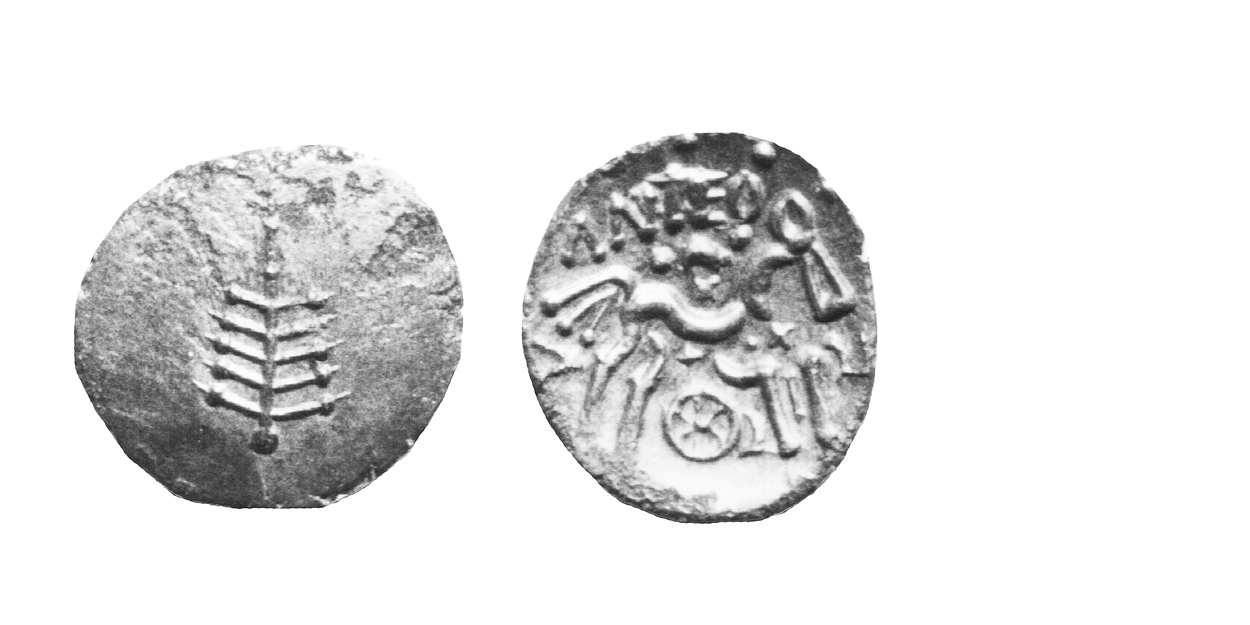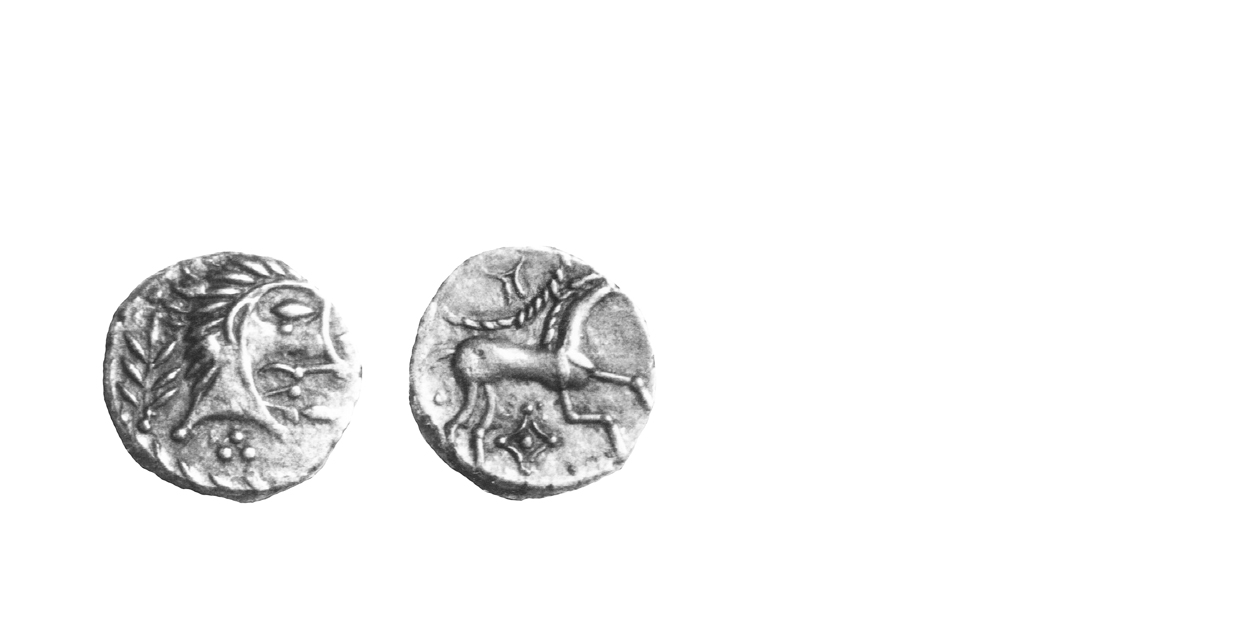Numismatic Articles
Van Arsdell 2015e (Info)
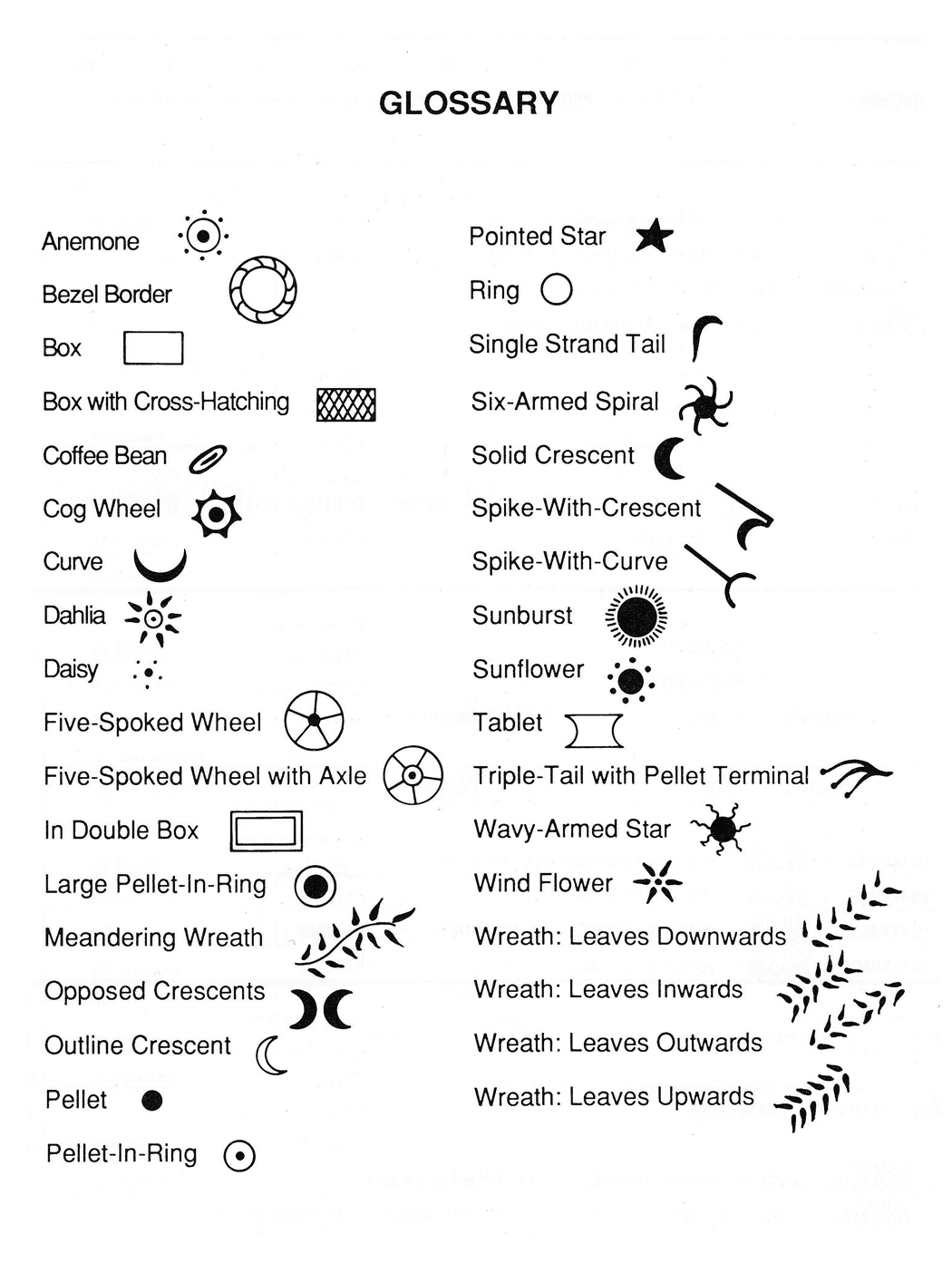
Semiotics of Celtic Coins X – Inventions, Replicas and Applying the Brakes
By Robert D. Van Arsdell
Why haven’t image-tables like the one shown above increased our knowledge of Celtic coins in any significant way?
They appear in all sorts of numismatic works – handy tables of images grouped in categories. A non-Celtic one has appeared for decades in Spink’s Coins of England and the United Kingdom, listing the privy marks on hammered coins, grouped by crosses, stars, etc.
The glossary above lists the field objects found on Ancient British coins. It’s the one used to catalogue coins on this site. The images are listed alphabetically with no attempt at grouping.
The most detailed table is Hobbs’ “Symbols Plates”, in which the field objects are thoughtfully arranged in detailed categories (info). Cataloguers use these kinds of tables because they simplify writing the coin descriptions.
However, one wonders why these tables have never become a source of inspiration for semiotic studies. I‘ve known archaeologists who constructed similar tables so they could analyze Celtic coinage. They initially believed the arrangement of categories would give some insight into the meaning of the images. This never proved to be the case, they found nothing – and eventually gave up.
Image tables as semiotic tools
The reason these tables don’t work as semiotic tools is that they are only arranged by denotations. The heads are put in one group, the flowers and sunbursts in others. The meaning of the images on Celtic Coins cannot be analyzed by simply looking at the denotations.
The meaning is analyzed instead by a complex array of denotations and connotations called a sememe diagram (info) Grouping images by denotations misses entirely the content of the connotations, the place where most of the “meaning” lurks.
(For explanation see: Van Arsdell (2007b) (2008a) (2008b) )
The process of listing also ignores the possibility that the meaning changes with the circumstances of the viewer – the possibility that different viewers look at the same coins and come away with different messages.
Furthermore, the lists make it impossible to find Amalgamation Switchers. A combination of images sometimes means something more than the images taken singly. The lists make it hard to spot these important combined images.
The semiotics
Umberto Eco goes to great lengths to show that arranging images by types isn’t a useful analysis (info). He dismisses Peirce’s “Symbols, Icons, Indices” idea as naïve (info).
He proposes instead, that images be categorized by the way the image was produced (info) (background).
Grouping images by the way they were produced yields unexpected results. Suddenly, we can predict the kinds of meanings we are likely to uncover for different sorts of images. We know when we are looking for too deep a meaning in an image, and alternatively when we should look for complex messages. We also gain some insight into the problems the rulers faced when trying to communicate their ideas to the people.
Eco constructed a complex diagram for categorizing methods of image-creation (info). I have found two of these methods useful for Celtic Numismatics. They are:
- Inventions produced via Ratio Difficilis
- Replicas produced via Ratio Facilis
These terms are admittedly impossible to use in easy discourse, so I will replace them with the shorthand: Inventions and Replicas.
Inventions are complex images, ones combining several image-elements. Replicas, in the case of Celtic coins, tend to be things we call Emblems.
Inventions
Inventions are produced when the creator is trying to express a complicated idea. The ruler may not even be able to express the idea clearly in words. The creator builds up the image using various bits and pieces. Metaphor may become involved at times. Each of the elements adds part of the meaning. The elements may then combine to switch the meaning into the complete idea the creator is trying to communicate. The creative process, itself, is very complicated (info). When analyzing Inventions, the resulting sememe diagrams can be very large and elaborate.
The first nine articles in this series largely dealt with these complex images. Now we will turn to Replicas.
Replicas
Replicas (emblems) are produced when a very simple message is intended. The message may involve a very small sememe diagram – perhaps just one denotation and one connotation. A few examples of replicas would include:
- Flags: denoting a country with the connotation the country is officially involved somehow
- Cartoon characters: “Uncle Sam”, “John Bull” or “Marianne” again denoting nations
- Heraldic devices: the lion, thistle, harp, etc. denoting families, peoples or nations
- Logos denoting companies, organizations or institutions
- Emblems: denoting individuals, families, peoples or nations
With Replicas, the image is already in use and the meaning is widely understood. The image is simply adapted to a new use, with the expectation that everyone will get the idea. An example would be taking the image from a flag and placing it on a coin.
On Celtic Coins, the best example occurred when the Dobunni placed a branched emblem on their staters. It denotes something like “the Dobunnic people” or “the leaders of the Dobunni”. A simple connotation would be “this coin was made by the Dobunni”. The Dobunni likely used the parent image in many ways and for a long time prior to placing it on their gold staters. The coin image is a Replica.
There is no reason to look for any deeper meaning. To do so would imply that we believe the image is an Invention. We would have no justification for making that choice unless we had some compelling piece of evidence that forced us to do so. Had an ancient author written that the Dobunnic Emblem was a symbol with a deep and complicated meaning, we might be persuaded to look further. But we have no such evidence and should only consider it a Replica.
Generally, when constructing sememe diagrams, Replicas are best undercoded. They should not be overcoded without compelling reasons to do so (info) (For explanation see: Van Arsdell 2010a)
A familiar Replica: the Dobunnic Emblem
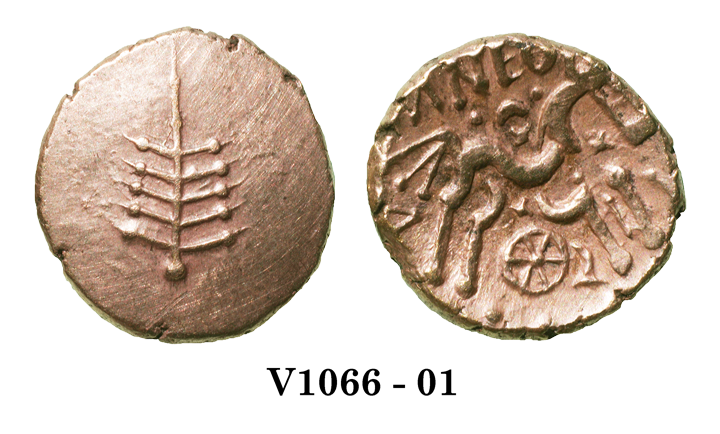
The Dobunnic Branched Emblem, shown here on a stater of Antedrig, appears on most Dobunnic gold (see catalogue listing). It was used virtually unchanged for more than eighty years. It must have been a common symbol, one that everyone recognized and understood in ancient times.
Allen certainly interpreted the symbol correctly when he suggested it “looks like a kind of national device on these coins, to be compared with a charge on a shield” (info).
Many have tried to determine what the symbol is (kind of plant, tree, etc.), or find a source from which the image was copied (info). These efforts have not turned up anything convincing.
The Dobunnic Emblem was likely a familiar image that the Dobunni copied onto their first gold staters. Allen’s suggestion that it could have been a symbol displayed on Dobunnic shields is not so far-fetched – but we will probably never know for certain.
The sememe diagram we would construct for the image would have just one denotation: “Dobunnic Emblem”; and one connotation: “this is a coin issued by the Dobunni”. We should undercode the sememe diagram in this way, looking for no “deeper” meaning.
There remains the possibility that the image on the obverse and those on the reverse combine to produce a new meaning (an Amalgamation Switch takes place). But there is no evidence from other sources to suggest they do.
Replica or Invention – how you do tell the difference?
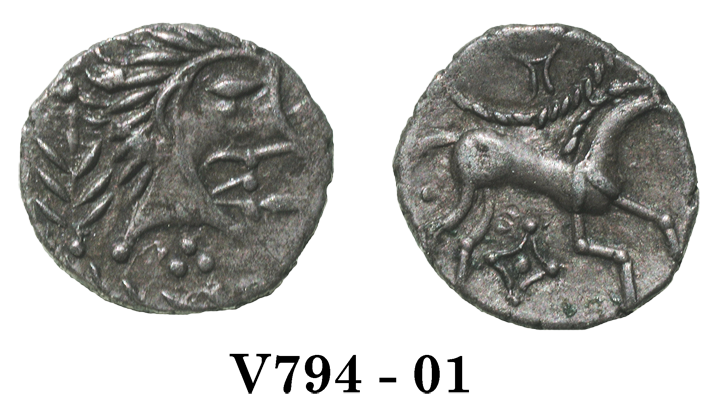
The Icenian silver coin shown above has a branched object on the obverse (see catalogue listing). The object looks similar to, but not exactly like, the Dobunnic Emblem.
The image on the silver coin has six branches, with a pellet at the bottom of the “stalk”. The Dobunnic Emblem has ten branches, with a pellet towards the end of each. The Dobunnic Emblem always displays the branches much more splayed than those on the Icenian coin. One could argue the Iceni didn’t have enough room on the coin to display a Dobunnic Emblem properly, but this doesn’t sound very convincing.
We could ignore these problems and assert the Icenian coin shows an Icenian image (the head) next to a Dobunnic Emblem. The head has been described as a “Norfolk God” (info).
Why not suggest the Dobunni have become allies of that Norfolk God? Why not assert that Boudicca was a Dobunnic princess? Perhaps she’s buried somewhere in Gloucestershire…. has anyone found a mirror in a grave? The coin proves it, yes?
Well, no it doesn’t. Perhaps that’s why no one has made any of these wild speculations.
To justify these kinds of speculations, we would certainly want some sort of corroborating evidence. An ancient account mentioning that the Dobunni and Iceni were allies during the Boudiccan Rebellion would do nicely. But there is no such evidence, so we only have the coin imagery to go on.
Semiotic analysis of the situation
The first question we should ask is whether the image is a Replica, or whether it’s an Invention. For the image to be a Replica we would expect a single object, perhaps with an explanatory inscription. This is not the case here – there are two image elements, and we should be wary that an Amalgamation Switch is occurring.
The image on the obverse is probably an Invention produced via ratio difficilis – one of those multifaceted images with a complicated meaning. We would analyze the two image elements separately and then look to see if their meanings combine to produce a completely new meaning. We would then search for other kinds of evidence to support our analysis.
Applying the brakes
This is where we reach a dead end with V794. We can’t be sure the branched object really is the Dobunnic Emblem (it isn’t a close enough match). We don’t even know the head is a Norfolk God (that’s just an unsubstantiated speculation).
So what do we really know here? I suggest we know very little about the meaning of this image. It probably has a complex sememe diagram involving an Amalgamation Switch. But in the absence of further information, we should stop there. Overcoding, at this point, would be the wrong thing to do.
Semiotic analysis can tell you when to apply the brakes.
End

